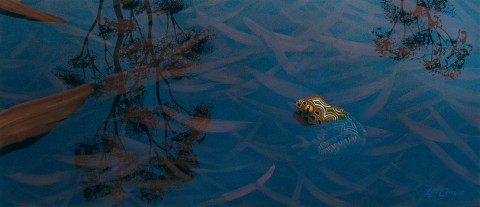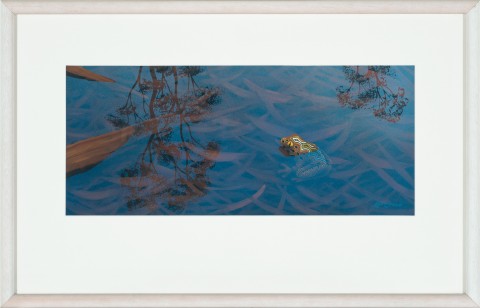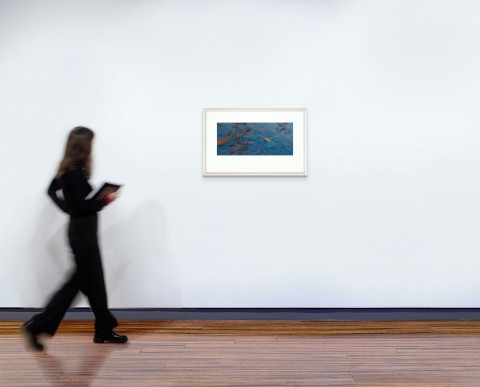GARKMAN, 1995
LIN ONUS
gouache on illustration board
27.0 x 63.0 cm
signed lower right: Lin Onus
Gallery Gabrielle Pizzi, Melbourne (label attached verso)
Private collection, Melbourne, acquired from the above in September 1995
probably Lin Onus Bama-Mutjing (Barmah – My Father’s Country), Gallery Gabrielle Pizzi, Melbourne, 12 September – 8 October 1995
Garkman, 1995 displays the sublime tranquillity that Lin Onus derived from a cultural and spiritual interaction with the land. A single frog, the eponymous ‘garkman’, rests in the shallows of this environmental sanctuary, inviting peaceful contemplation. Although its head pierces the surface of the water, not a single ripple emanates, the flat and glassy plane perfectly reflecting the silhouettes of two gum trees bordering this body of water. Depicted from above, Onus’ narrow and deceptively sparse composition provides no identifying land features or horizon, alluding to an expansive sense of custodianship and incontrovertible timeless belonging.
A self-taught artist living in suburban Melbourne, Onus was influenced by the relationships his father had cultivated with older, Indigenous artists who, in the absence of traditional cultural initiations, had been successful in using a European landscape tradition to depict their ancestral lands: Albert Namatjira (1902 – 1959), Ronald Bull (1942 – 1979) and Revel Cooper (c.1934 – 1983). Art historian Sylvia Kleinert has interpreted Lin Onus’ depiction of land as a ‘means of retrieving and rewriting history'; its multilayered presentation illustrates a ‘cultural archive.’1 The trompe l’oeil effects of Onus’ early photorealistic style provide the foundation for the ‘real and illusory collaging’ of his water-and-reflection paintings of the mid-1990s such as Garkman.2
The Aboriginal Arts Board of the Australia Council facilitated a transformative visit for Onus to Maningrida in the Northern Territory in 1986 – a ‘spiritual awakening’3 during which he met Senior Yolŋu artist, Djiwul (Jack) Wunuwun. The long partnership with Wunuwun, and particularly his adoption of Onus into the family, provided the artist with a deep initiation into the Yolŋu culture of the Murrungun people of East Arnhem Land – giving him authority to paint some of their cultural motifs. In the late 1980s, Wunuwun had pioneered the use of Western three-dimensionality, transparency and perspective in bark painting to illustrate the coexistence and transitions between physical and spiritual realms, inspiring Onus to reconcile multiple views in his artworks.4
Translucent and multilayered, Onus’ watery landscape of trees and a riverbed of leaves features an ‘indigenised’ frog, painted in colours and designs mimicking bark painting in natural ochres from Arnhem Land. ‘Garkman’ is a generic Yolŋu name for all frog species in Arnhem Land, used by both Dhuwa and Yirritja moieties, and symbolises the wet season, celebrating the renewal of life with the coming rains.5 Onus spoke of his affinity with these creatures, which often feature in his works, following his assimilation into this community: ‘Having a skin name you know who else you’re automatically related to… you get to know all the Dhuwa creatures, so these creatures become your countrymen, they’re part of me and I’m part of them now.’6
1. Kleinert, S., ‘Aboriginal Enterprises: negotiating an urban Aboriginality’, Aboriginal History, vol. 34, 2010
2. O’Ferral, M., ‘Lin Onus’, in Lynn, V. (ed.), Australian Perspecta 1991, Art Gallery of New South Wales, Sydney, 1991, p. 80
3. Lin Onus, cited in Leslie, D., ‘Earth, spirit and belonging in Australian art’, Spirit in the Land, McClelland Gallery + Sculpture Park, Langwarrin, 2010 – 2011, p. 19
4. ‘Jack Wunuwun - Barnumbirr the Morning Star 1987’ in Caruana, W., and Cubillo, F., Aboriginal & Torres Strait Islander art: collection highlights from the National Gallery of Australia, National Gallery of Australia, Canberra, 2010, p. 187
5. Boll, V., ‘The distribution and ethnozoology of frogs (and toad) in north-eastern Arnhem Land (Australia)’, Anthropozoologica, vol. 39, issue 2, 2004, p. 67
6. Lin Onus, Interview recorded with Donna Leslie, 30 Jan 1995, cited in Neale, M., Urban Dingo - the Art and Life of Lin Onus 1948 – 1996, Queensland Art Gallery, Brisbane, 2000, p. 14 – 15
LUCIE REEVES-SMITH


